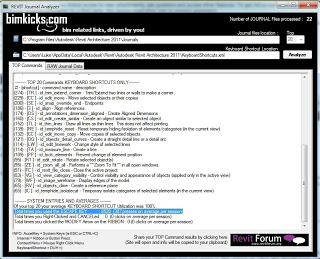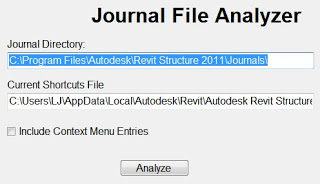Great ‘glossary’ post on parameter categories in Revit:
Parameter
Project Parameters
Family Parameters
Shared Parameters
Type Parameters
Instance Parameters
Revit ST: Revit – Understanding Parameters
Month: March 2011
“if you have a Length parameter, and try to use a (Length * Length) formula, you´ll get the ” Inconsistent Units” error, because (Length * Length = Length Squared). Only way around is to neutralize the units on at least one of the parameters in the formula. The easiest way to neutralize a unit is by…”
Jose Guia has also responded to the challenge. Here is a direct link to the program he created:
RevitUsageAnalyzer.zip
EDIT: Jose’s blog seems to be down, here is a link that works
https://docs.google.com/file/d/0B1dGdRkpk2beU1Y2dHBMY085RkU/edit?usp=sharing
He has done a nice job – his program is a little bit more advanced than Rod Howarth’s version. He includes a few more statistics, and the folders are already setup for RAC. It also links into the Revit Forum thread.
This is a scary stat from my analysis:
Total times you used the ESCAPE KEY : 8520 (387 presses on average per session)
Nasty!
Here is his blog post:
blog.bimkicks.com | Revit Journal Analysis and Parsing Program (Rank Keyboard Shortcut Use)
Here is the Revit Forum post. You can put your results here.
Revit Journal Analysis and Parsing Program (Keyboard Shortcut Use)
Give it a go.
Are these the most powerful and significant changes in Revit 2012?
YouTube – New in Revit 2012: Construction Modeling & Assemblies
If you have 2 mins, watch this!
I can definitely see architectural applications for this:
- aerial photography
- high rise building analysis (check if maintenance required)
- deliver lunch to hard to access building sites
Revit does not want you to place a slab edge on part of a slab that is sloping (because it has been shape-edited).
However, you can ‘trick’ Revit into letting this happen by:
- Setting the edge you want the Slab Edge to go on to be ‘flat’ by temporarily point editing the slab.
- Then place the Slab Edge (Revit will allow you to, now that the edge is flat).
- Adjust the points back to how you want them.
The Slab Edge should happily follow the sloping edge now.
A bit of a workaround, but it does work…
Just spent two minutes trying to select an errant object in #Revit. It was a piece of dust.
“
the solids’ cut material when in Course Detail Level is controlled by a special Material called “Poche”.
“
Revit Learning Club Blog: Section Boxes in perspective views
Rod Howarth has done a great job in responding to the challenge I presented a fortnight ago. He has created a simple yet effective program that analyzes your journal files and tells you the Top 20 commands that you are triggering WITH Keyboard Shortcuts, and the Top 20 commands you are triggering WITHOUT Keyboard Shortcuts.
Most of us realize that the fastest way to trigger a command is by using the keyboard. Yes, the Ribbon is lovely in its own way, but once you know what command you want, why would you want to spend 3 or 4 clicks getting there, when a simple press or two on the keyboard will do the same thing?
Here is a link to the Journal File Analyzer post by Rod.
Here is a direct link to the Journal File Analyzer program.
I will post later about the paths to use if you don’t know them already.
Also, don’t include “” marks in the path entries.


